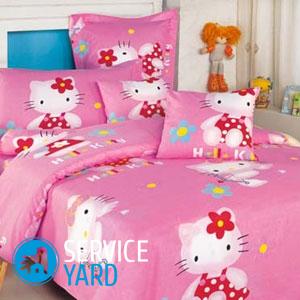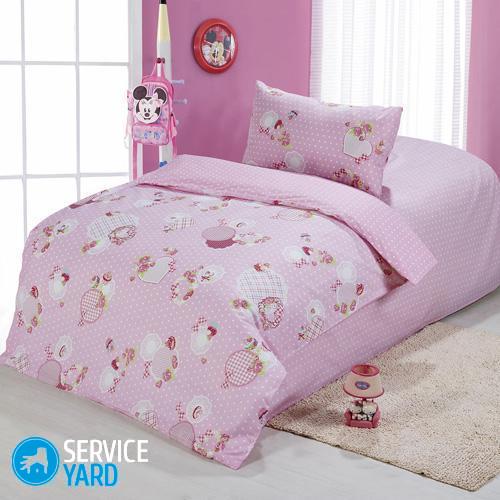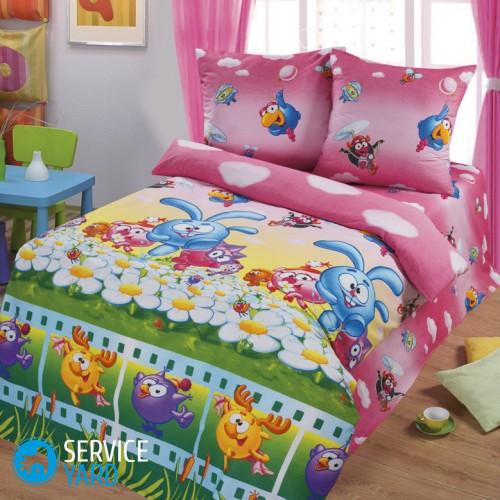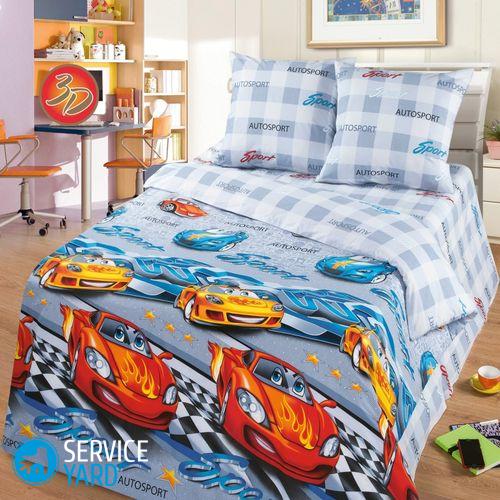How to sew a high-quality children's duvet cover

- Why sew baby bedding yourself?
- General recommendations for sewing
- Consumption of material for sewing linen for bedding a newborn
- How to sew a children's duvet cover: stages of work
- How to sew an elastic sheet on your own in a crib?
- What seam to use when sewing a bed set?
- Standard sizes for baby bedding sets
- Stock footage
Loving parents always try to create the most comfortable living conditions for their children. Since the child at the beginning of his life spends most of his time in a dream, comfort in the crib is very important. Baby bedding is one of the main factors that help your baby relax and feel protected. It’s easy to sew a children's duvet cover, pillowcase, and even more so a sheet. A little of your time, and the child will receive a beautiful bed with the picture you like.
to contents ↑Why sew baby bedding yourself?
Some parents in this process see continuous downsides. This is a waste of time, energy on the choice of fabric, as well as tailoring itself. But look at things from a different angle. So, the advantages of a self-sewn baby sleeping set:
- The children's duvet cover, pillowcase, bed sheet will be exactly those sizes that you need. The sheet will not hang ugly, the pillowcase will not squeeze the pillow, and the blanket will fit harmoniously into the children's duvet cover.
- The design of the bedding, namely the placement of the holes for the blankets in the children's duvet cover and the presence or absence of elastic in the sheet, will depend on your preferences.
- Figure, color of bedding, an older child will be able to choose on their own.
- Self-tailoring of children's bedding will significantly save the family budget.
to contents ↑Important! According to the recommendations of the psychologist, fabrics of blue, beige or pink colors are best suited for baby bedding. Such colors will contribute to a calm, long-term sleep of the baby.
General recommendations for sewing
In order not to make unnecessary waste of money effort and your time, you should know how to most rationally approach the issue of sewing baby clothes in the crib:
- You will often wash and iron the children's duvet cover, pillowcase and sheet, so the fabric should be dense and of high quality.
Important! When buying fabric, pay attention to labels with instructions regarding the temperature of washing and ironing.
- When choosing matter for these purposes, be based on the principle: the more natural, the better. A large amount of synthetics is simply unacceptable for a child and especially a newborn.
Important! A fabric with a natural composition tends to shrink when washed. Therefore, you should make an allowance for seam and shrinkage, cutting out a children's duvet cover.
- If you still do not know how to sew a children's duvet cover with your own hands, then choose a large canvas. It is easier to work with such fabric both in a cut and in tailoring itself. Also, wide matter will help to avoid seams in the middle of the finished product. An ideal option would be if the width of the fabric matches the width of the blanket.
Important! The optimum textile width for sewing baby bedding is considered to be 2.2 m wide.
- When cutting, it is recommended to place the fabric so that the shared thread runs along the length of the product. Thus, you will avoid changing the shape and size of the baby duvet cover after washing.
Important! When buying fabric, make sure that the seller cuts the piece you need exactly, without distortions. The presence of distortions will greatly complicate the cutting and sewing of bedding for a child.
For children's sets, the following fabrics are used:
- Cotton is an environmentally friendly material, soft and pleasant to the touch.
- Chintz is a lightweight cotton canvas.
- Atlas is a dense silk material, the front side of which is smooth and shiny. This fabric is used, as a rule, for sewing adult bedding.
- Flax - has a smooth surface and a matte sheen.
- Satin Suite is a sturdy canvas with shine.
- Poplin is a cotton fabric with a silk admixture.
- Polyester - soft material of synthetic origin. For the manufacture of sets in the crib for children is used extremely rarely.
to contents ↑Important! Coarse calico, ranfors and super cotton are also often used, which have a tight binding of threads and are therefore durable.
Consumption of material for sewing linen for bedding a newborn
- Based on the standard sizes of bedding, you will need approximately 4.5 m of fabric, taking into account allowances and shrinkage.
- On the duvet cover: with a canvas width of 2.2 m, you will need 143 cm.
How to sew a children's duvet cover: stages of work
You will need it directly for work: fabric, scissors, threads and a sewing machine. And the sewing process looks like this:
- The first step is to measure the width and length of the blanket. To the results obtained, it is required to add 5 cm to the allowances for seams, taking into account shrinkage.
- The simplest option is a duvet cover, which consists of two rectangles. Each of them along the perimeter is processed by a seam along the edges bent twice by 0.5 cm.
Important! It is recommended to wash, dry and iron the fabric before cutting. After such procedures, the canvas will not sit down in the future, and you will operate on real dimensions.
- The processed rectangles are folded facing each other and sew on three sides.
- On the fourth unbroken side, it is necessary to outline a hole through which the blanket will protrude inside.
Important! First think about which side the blanket hole will be on the side or bottom.
- Sew the remaining side to the marks, and mark the edges of the holes with a fastening stitch-clip.
Important! In order to prevent the blanket from falling out of the duvet cover, you can sew adhesive tape, zippers, buttons or buttons into the gap.
- Iron the finished duvet cover with an iron and insert a blanket into it.
Decorate your creation
You can decorate a children's duvet cover with the help of quilling, lace, appliqués, embroidery and other methods that your fantasy tells you with your child. You should decorate a duvet cover only on one side of the face, so that only soft, natural fabric touches the baby’s body.
to contents ↑How to sew an elastic sheet on your own in a crib?
The calculation of material consumption for such a sheet should be done according to the following formula:
- The width of the mattress + 2 * the thickness of the mattress + 2 * 2 cm (at the seams) + 2 * 6 cm (allowance).
- The length of the mattress + 2 * the thickness of the mattress + 2 * 2 cm (at the seams) + 2 * 6 cm (allowance).
Important! With a width of the mattress of 60 cm, a length of 120 cm and a thickness of 12 cm, you will need to carve out a rectangle with sides 100x160 cm.
Work Stages:
- Fold the piece of fabric four times and cut a square in the corner.
- We sweep the corners and try on a children's mattress.
- We sew and process slices.
- We left 2 cm on the hem. We twist the edges and sew, leaving at a distance of 25 cm from the corners of the 4 holes for inserting the elastic.
- We insert an elastic band into the sheet, tighten and sew on its ends.
The elastic sheet is ready.
to contents ↑Important! This type of mattress cover is very convenient, because the sheet does not slip and does not wrinkle under the child, it looks neat and beautiful.
What seam to use when sewing a bed set?
The best for such purposes is a linen seam. To execute it is quite simple:
- Fold the fabric with the wrong side inward and stitch it, backing 0.5 cm from the edge.
- Unscrew the seam so that the wrong side of the fabric is facing out and sew again, backing away from the edge of 0.7 cm.
- After following the above recommendations, sew the seam allowance to the fabric.
Standard sizes for baby bedding sets
The sizes of linen in a crib depend on the age of the child and the dimensions of his bed.
Standard sizes of baby bedding for a newborn
Infants spend most of the first six months of their life in the crib, so it is important that the baby duvet cover, sheet and pillowcase are comfortable, practical and like the baby.
- Duvet cover for a newborn - 112x147 cm.
- Sheet - 110x150 cm.
- Pillowcase - 40x60 cm.
Single bedding
As a rule, an older child sleeps in a single bed, the standard sizes of linen for which are as follows:
- Duvet cover: 115x147 cm.
- Sheet: 120x150 cm.
- Pillowcase 40x60 cm.
Standard sizes for bedding for teens
When choosing fabric for a teenage bedding set, it is worth considering the design preferences of the teenager himself. Regarding sizes, the kit has the following parameters:
- Duvet cover - 145x215 cm.
- Sheet - 150x220 cm.
- Pillowcase - 50x70 cm.
Double sets for children
Not as often as single, but still in demand and double sets of linen for the child. Such sets include one sheet, one duvet cover and two pillowcases. Their sizes are as follows:
- Sheet - 180x260 cm.
- Duvet cover - 160x220 cm.
- Pillowcase - 50x70 cm.
European linen sets
European standards, which are more common abroad, but are also found in our country, are not significant, but still differ from our parameters for bed sets:
- Duvet cover - 200x220 cm.
- Sheet - 215x240 cm.
- Pillowcase - 50x70 cm.
Sizes of a bed set for kindergarten
Often, kindergartens require parents to bring a set of bed linen for their child. It must satisfy the requirements of the sanitary station. The following fabrics are most suitable for such purposes: calico, linen, satin, chintz.
The sizes of such kits are as follows:
- Sheet - 100x145 cm.
- Duvet cover - 110x145 cm.
- Pillowcase - 40x60 cm.
Stock footage
Self-tailoring of baby bedding will not take you as much time as it seems initially. Involve the child in the sewing process, then the pleasure of work and the result will be twice as much.
- How to choose a vacuum cleaner taking into account the characteristics of the house and coatings?
- What to look for when choosing a water delivery
- How to quickly create comfort at home - tips for housewives
- How to choose the perfect TV - useful tips
- What to look for when choosing blinds
- What should be running shoes?
- What useful things can you buy in a hardware store
- Iphone 11 pro max review
- Than iPhone is better than Android smartphones






